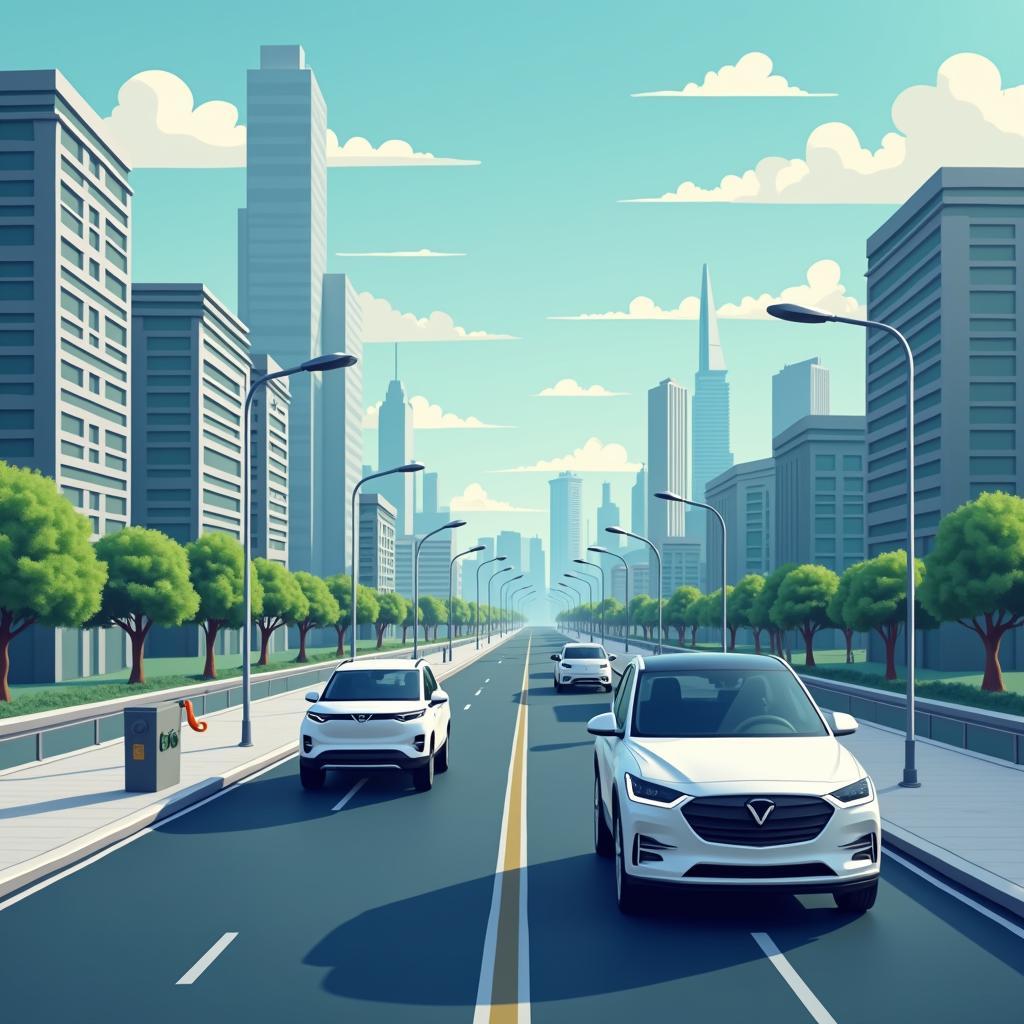Mở Bài
Chủ đề “Xe điện chuyển đổi mạng lưới giao thông toàn cầu” (How Electric Vehicles Are Transforming Global Transportation Networks) là một trong những chủ đề hiện đại và phổ biến nhất trong các đề thi IELTS Reading thời gian gần đây. Với sự phát triển nhanh chóng của công nghệ xanh và nhu cầu giảm phát thải carbon, các bài đọc về xe điện, hạ tầng sạch và tương lai giao thông thường xuyên xuất hiện trong các kỳ thi chính thức.
Bài viết này cung cấp cho bạn một đề thi IELTS Reading mẫu hoàn chỉnh với 40 câu hỏi được phân chia thành 3 passages với độ khó tăng dần từ Easy (Band 5.0-6.5) đến Medium (Band 6.0-7.5) và Hard (Band 7.0-9.0). Đây chính là cấu trúc giống hệt các đề thi thực tế của IELTS. Bạn sẽ nhận được:
- 3 bài đọc tiếng Anh chuyên đề về xe điện và giao thông xanh với độ khó tăng dần
- 40 câu hỏi đa dạng bao gồm Multiple Choice, True/False/Not Given, Matching, Summary Completion và Short-answer Questions – những dạng câu hỏi phổ biến nhất trong kỳ thi thực tế
- Đáp án đầy đủ kèm giải thích chi tiết cho từng câu, giúp bạn hiểu rõ tại sao đáp án đó đúng
- Từ vựng học thuật được làm đậm trong các passages, kèm bảng từ vựng và collocations hữu ích
- Kỹ thuật làm bài thực chiến từ 20 năm giằng dạy IELTS của tôi
Đề thi mẫu này phù hợp với học viên đã đạt band 5.0 trở lên, muốn nâng cao kỹ năng Reading và sẵn sàng cho kỳ thi chính thức. Bạn có thể sử dụng đề này để luyện tập trong thời gian quy định 60 phút, hoặc học từng phần để nắm vững kỹ thuật.
 Xe điện thế hệ mới đang chuyển đổi mạng lưới giao thông toàn cầu
Xe điện thế hệ mới đang chuyển đổi mạng lưới giao thông toàn cầu
Hướng Dẫn Làm Bài IELTS Reading
Tổng Quan Về IELTS Reading Test
IELTS Reading là một trong bốn kỹ năng được đánh giá trong kỳ thi IELTS. Đây là phần thi đòi hỏi bạn phải đọc 3 đoạn văn bản (passages) và trả lời 40 câu hỏi trong vòng 60 phút, không có thời gian bổ sung.
Phân bổ thời gian khuyến nghị:
| Passage | Độ Khó | Thời Gian | Số Câu |
|---|---|---|---|
| Passage 1 | Easy | 15-17 phút | 13 câu |
| Passage 2 | Medium | 18-20 phút | 13 câu |
| Passage 3 | Hard | 23-25 phút | 14 câu |
| Tổng cộng | – | 60 phút | 40 câu |
Điều quan trọng là bạn cần quản lý thời gian hợp lý. Passages 1 và 2 tương đối nhanh, giúp bạn tích lũy điểm dễ. Passage 3 yêu cầu thời gian hơn do độ phức tạp cao hơn.
Các Dạng Câu Hỏi Trong Đề Thi Này
Đề thi mẫu dưới đây bao gồm các dạng câu hỏi chủ yếu sau:
1. Multiple Choice (MC)
- Chọn một đáp án đúng nhất từ 3-4 lựa chọn
- Yêu cầu: Hiểu chi tiết nội dung, phân biệt các ý tương tự
2. True/False/Not Given (TFNG)
- Phán đoán xem câu là Đúng (True), Sai (False) hay Không đề cập (Not Given)
- Lưu ý: “Not Given” là khi thông tin không có trong bài, không phải suy đoán
3. Matching Information (MI)
- Kết nối các thông tin/đặc điểm với các đoạn văn hoặc phần thích hợp
- Yêu cầu: Quét bài để tìm chi tiết cụ thể
4. Sentence Completion (SC)
- Điền từ vào chỗ trống để hoàn thành câu
- Yêu cầu: Tuân thủ giới hạn từ (thường không quá 2-3 từ)
5. Short-answer Questions (SAQ)
- Trả lời câu hỏi bằng từ hoặc cụm từ từ bài
- Yêu cầu: Trích xuất thông tin chính xác, không thêm thắt
IELTS Reading Practice Test
PASSAGE 1 – The Rise of Electric Vehicles: A Transportation Revolution
Độ khó: Easy (Band 5.0-6.5)
Thời gian đề xuất: 15-17 phút
The world of transportation is undergoing a dramatic transformation. Electric vehicles (EVs), once considered a niche market for environmentally conscious consumers, have become mainstream. This shift is being driven by advances in battery technology, government incentives, and growing concerns about climate change and air pollution.
The history of electric vehicles is longer than many people realize. In fact, EVs were popular in the early 1900s before the internal combustion engine became the dominant technology. However, the modern EV revolution began in earnest in the late 1990s and early 2000s, when companies like Tesla and manufacturers in Japan and Europe started developing commercially viable electric cars. Today, electric vehicles represent one of the fastest-growing segments of the automotive industry.
One of the key reasons for the surge in EV adoption is the significant improvement in battery technology. Modern lithium-ion batteries are lighter, more powerful, and more affordable than ever before. Battery costs have dropped by nearly 90% over the past decade, making electric vehicles more accessible to the average consumer. Additionally, the driving range of modern EVs has improved substantially. While early electric cars could only travel 100 kilometers on a single charge, today’s models can travel between 300 and 600 kilometers, comparable to conventional vehicles.
Government policies have also played a crucial role in promoting electric vehicle adoption. Many countries have introduced tax incentives, subsidies, and rebates to encourage consumers to purchase electric vehicles. For example, Norway has become a global leader in EV adoption, with over 80% of new car sales being electric vehicles, largely thanks to generous government incentives and tax benefits. Similarly, countries like Germany, France, and the United Kingdom have set ambitious goals to phase out gasoline-powered cars within the next two decades.
The environmental benefits of electric vehicles are substantial. Unlike conventional cars powered by fossil fuels, EVs produce zero tailpipe emissions, significantly reducing the level of air pollution in cities. Furthermore, when charged with electricity from renewable energy sources such as solar or wind power, electric vehicles are virtually carbon-neutral. Studies have shown that even when considering the carbon emissions from electricity generation, driving an electric vehicle is typically 50% more efficient than driving a gasoline-powered car.
Beyond environmental advantages, electric vehicles offer numerous practical benefits to consumers. They have lower operating costs, as electricity is significantly cheaper than petrol or diesel. Moreover, EVs require less maintenance than conventional vehicles, as they have fewer moving parts and no oil changes. The driving experience is also superior – electric motors provide instant torque, resulting in smooth and quiet acceleration.
However, the widespread adoption of electric vehicles also presents challenges. The most pressing concern is the need for adequate charging infrastructure. Most of the world’s major cities currently lack sufficient public charging stations to support a mass shift to electric vehicles. Building this infrastructure requires significant investment from both governments and the private sector. Additionally, sourcing materials for batteries, particularly lithium and cobalt, raises concerns about environmental sustainability and ethical mining practices.
Despite these challenges, the future of electric vehicles appears bright. Automakers around the world are investing heavily in EV research and development. Companies like Tesla, Volkswagen, and General Motors have announced ambitious plans to transition their entire product lines to electric vehicles within the next 10-15 years. As battery technology continues to improve and charging infrastructure expands, electric vehicles are expected to become the dominant form of transportation in the coming decades.
Questions 1-13
Instructions: Read the statements below and decide if the statements are True (T), False (F), or Not Given (NG). Write T, F, or NG next to the question number.
1. Electric vehicles were first invented in the early 1900s.
2. Tesla was the first company to develop commercially viable electric cars in the 1990s.
3. Modern lithium-ion batteries can travel between 300 and 600 kilometers on a single charge.
4. Battery costs have decreased by approximately 90% in the past decade.
5. Norway has implemented generous government incentives to promote electric vehicle adoption.
6. Electric vehicles produce more air pollution than conventional cars.
7. Electric vehicles charged with renewable energy produce zero carbon emissions.
8. Electric vehicles have lower operating costs compared to gasoline-powered cars.
9. Lithium and cobalt are the primary concerns in battery production.
10. Volkswagen has announced plans to transition entirely to electric vehicles within 10-15 years.
Multiple Choice: Choose the correct answer A, B, C, or D.
11. According to the passage, what is the main reason for the surge in EV adoption?
A) Government policies have been more effective than technology improvements
B) Improvements in battery technology, price reductions, and better driving range
C) Consumer concerns about fossil fuel pollution
D) The popularity of electric vehicles in the early 1900s
12. Which of the following countries is mentioned as a global leader in EV adoption?
A) Germany
B) France
C) Norway
D) United Kingdom
13. According to the passage, what is the most pressing concern regarding widespread EV adoption?
A) The availability of parking spaces
B) The lack of adequate charging infrastructure
C) The reliability of battery technology
D) The cost of electric vehicles
PASSAGE 2 – Building the Electric Highway: Global Infrastructure Development
Độ khó: Medium (Band 6.0-7.5)
Thời gian đề xuất: 18-20 phút
The transition to electric vehicles represents more than a shift in consumer choice; it demands a comprehensive overhaul of global transportation infrastructure. While individual consumers focus on purchasing decisions, governments and corporations face the monumental task of constructing the necessary charging networks to support this revolutionary change. This infrastructure challenge has become increasingly critical as EV sales accelerate and manufacturers commit to electrification timelines.
One of the most significant achievements in recent years has been the development of ultra-fast charging technology. Modern charging stations can now replenish a vehicle’s battery to 80% capacity in as little as 20-30 minutes, transforming the practicality of long-distance travel for electric vehicle owners. Companies like Tesla have pioneered the Supercharger network, strategically positioning charging stations along major highways and in urban centers. The Supercharger network now comprises over 50,000 charging points globally, facilitating seamless travel across continents. These charging hubs have become as essential to the EV ecosystem as gas stations were to the internal combustion engine era.
However, the distribution of charging infrastructure remains uneven across different regions. Developed nations in Western Europe, North America, and East Asia have made substantial investments in charging networks, while developing countries lag significantly behind. This disparity raises concerns about the equitable democratization of electric vehicle technology worldwide. Without investment in charging infrastructure in emerging markets, electric vehicles may remain a luxury product accessible only to affluent consumers in wealthy nations, thereby limiting the global environmental impact of the EV revolution.
The financial implications of building charging infrastructure are substantial. Estimates suggest that creating a comprehensive global charging network would require investments exceeding $2 trillion by 2040. This astronomical figure necessitates collaborative efforts between public and private sectors. Governments must provide regulatory frameworks and initial capital investment, while private companies contribute technology, expertise, and operational efficiency. Public-private partnerships have emerged as a viable model for accelerating infrastructure development. In numerous countries, consortiums of oil companies, automotive manufacturers, and energy providers have formed alliances to expedite charging network expansion.
Another crucial dimension of infrastructure development involves upgrading the electrical grid to handle the increased demand for electricity. As more vehicles transition to electric power, electricity consumption patterns will shift dramatically. Peak charging times could strain existing power systems, particularly in regions already facing energy shortages. Smart grid technology, incorporating renewable energy integration and demand-response systems, offers potential solutions. These systems can balance electricity supply and demand dynamically, prioritizing charging during periods of abundant renewable energy generation and reducing charging during peak demand hours.
Apartment dwellers and urban residents without dedicated parking present another infrastructure challenge. Approximately one-third of the global population lives in apartments or multi-unit dwellings where installing personal charging stations is impractical. Public charging networks must therefore be denser and more accessible in urban areas. Cities like Amsterdam and Copenhagen have pioneered innovative solutions, including streetside charging poles and cable systems that permit convenient charging for residents without private parking. These models demonstrate that thoughtful urban planning can accommodate the infrastructure requirements of mass EV adoption.
The role of workplace charging has gained prominence in infrastructure planning. Employers increasingly recognize that providing charging facilities offers substantial benefits: employees can charge vehicles during working hours, thereby reducing dependency on home charging and accelerating overall vehicle charging rates. Progressive companies have installed thousands of charging stations at offices and manufacturing facilities. This decentralized approach to charging infrastructure distributes the load across multiple locations, reducing pressure on residential networks and public systems.
Regarding technological standardization, the global EV industry has achieved greater consensus than existed during earlier phases of automotive electrification. Most major manufacturers now support common charging standards, particularly the Combined Charging System (CCS) and China’s GB/T standard. This convergence on standards has eliminated many incompatibility issues that previously complicated EV ownership. Drivers can confidently utilize charging networks across different countries without concerning themselves about connector compatibility.
Looking ahead, autonomous electric vehicles and vehicle-to-grid (V2G) technology promise to further revolutionize infrastructure dynamics. V2G technology enables EVs to discharge stored energy back into the electrical grid during peak demand periods, effectively transforming vehicles into mobile energy storage units. This capability could significantly alleviate grid strain and optimize electricity distribution across networks. Autonomous vehicles operating as shared mobility services, rather than individually owned transportation, could substantially reduce the total number of vehicles required on roads, thereby moderating infrastructure demands.
Questions 14-26
Matching Information: The passage mentions several topics below. Match each topic (14-19) with the correct paragraph (A-H). You may use each letter more than once.
A) Paragraph 1
B) Paragraph 2
C) Paragraph 3
D) Paragraph 4
E) Paragraph 5
F) Paragraph 6
G) Paragraph 7
H) Paragraph 8
**14.


